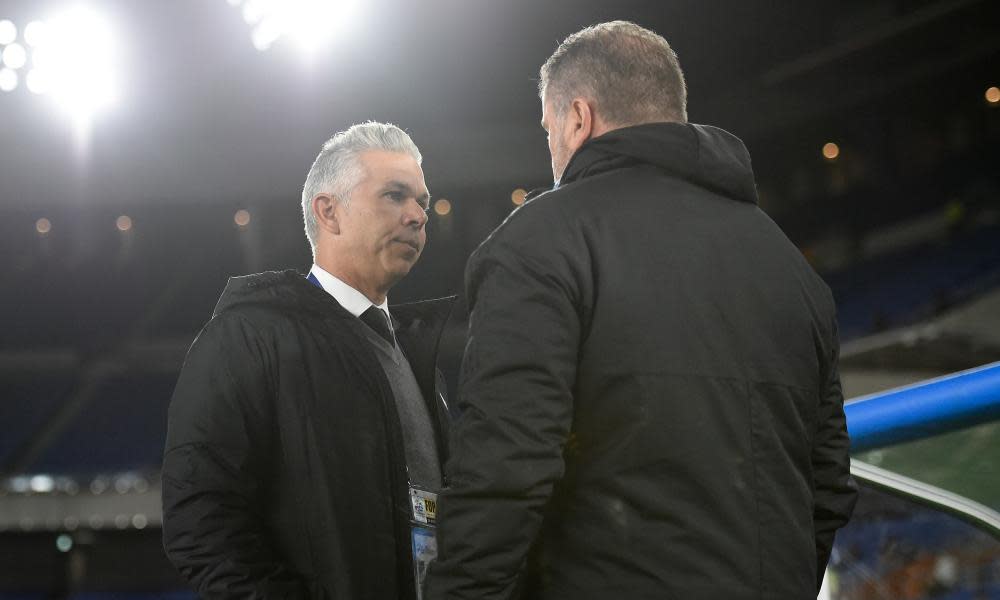Ange Postecoglou showed us the chasm – but soon we could miss out in Asia entirely

It was billed as Australia’s most anticipated AFC Champions League match since Western Sydney Wanderers faced Al-Hilal in the 2014 final. Ange Postecoglou vs Sydney FC. Australia’s best domestically-produced coach vs the A-League’s first serial win machine.
But over 90-plus minutes of exhilarating football, the four-time NSL and A-League championship winner laid bare to Australian football supporters the gaping chasm between where the domestic game is, and where it could be.
On a cool night in Yokohama, bristling energetically towards a 4-0 victory, Postecoglou’s Marinos side were irrefutable. His players pressed with intensity, broke with precision and pace, played crisp, sharp passes, and moved off-the-ball in a way that tore Sydney FC’s defence apart like tissue paper. Central defenders Alex Wilkinson and Ryan McGowan played at a World Cup under Postecoglou – but they had no answers for the attacking fluidity of his new team. Kosta Barbarouses, Luke Brattan and Andrew Redmayne were part of his infamous “Roarcelona” in 2011. But they could do little to stop his exponentially improved version, nearly a decade on.
Related: Ange Postecoglou: 'Australian football is going backwards' | Oliver Trenchard
During his fractious departure from Australian football in 2017, Postecoglou urged administrators to share his ambition for the sport in Australia. They didn’t; he found somebody else who would listen.
The manner of Sydney FC’s dismantling will prompt negativity. But the more worrying news for Australian football came last month, and without fanfare.
In announcing its latest club competition rankings the AFC delivered a bombshell: Australia had dropped six places to 17th in the region – behind nations like North Korea, Turkmenistan or the Philippines.
A calculation based on the last four years of club team performances in the AFC Champions League and the AFC Cup (a secondary competition akin to Europe’s UEFA Cup) – the rankings are used to determine each nation’s allocation in future competitions.
Following the Wanderers’ triumph in 2014, Australia were ranked sixth. By year’s end in 2017, Australia were eighth; by 2019, eleventh. With the 2020 end-of-year ranking used to determine the 2022 allocations, by falling behind Eastern conference rivals Thailand, Philippines, North Korea and Vietnam, Australia could see its representation in Asia’s top club competition reduced from three – to either zero or one.
For clubs looking to build their visibility in the world’s most populous region, the ramifications of this are mindboggling. For owners like Perth Glory’s Tony Sage with significant mining interests, participation in Asia is the game. For sponsors, exposure to 4.5bn eyeballs adds untold value. For clubs looking to raise revenue via transfer fees, having your players in the Champions League is everything.
Just as critical as Sydney’s heavy loss to Yokohama therefore was Perth’s unlucky 1-0 loss to FC Tokyo via a late deflected goal, and Melbourne Victory’s 1-0 loss to FC Seoul, both 24 hours earlier. And more crucially than all of these was Victory’s matchday one 1-0 win over Thailand’s Chiangrai United – given the likelihood of Australia being in direct competition with Thailand for 2022 allocations. Every win – especially against emerging rivals – becomes paramount.
In 2019 Australian clubs played 12 group stage games without a single win. In 2018 Sydney FC and Melbourne Victory faired marginally better. In 2017 it was Brisbane Roar, Western Sydney Wanderers and Adelaide United who all fell at the group stage.
With clubs either deprioritising the continental competition or increasingly unequipped to prosper in it, it’s a cautionary tale of club-level narrow-mindedness and league-wide lack of foresight. The kind of situation that Postecoglou railed against in 2017 and begged administrators to heed.
And yet the gulf between Asia’s pedigree clubs and its also-rans has only exacerbated across the past four seasons.
Between 2015-2020 Chinese clubs spent an eye-watering $1.54bn on player transfers (and that’s merely those for which fees have been disclosed). Clubs in the Saudi Pro League threw out at least $337m, the UAE Gulf League $157m and the Qatari Stars League $100m.
Such flagrant spending could, and should never, be emulated by Australian clubs – but it shows the scale of investment circulating rival leagues across Asia – investment that Australian clubs and players are increasingly peripheral to as the men’s domestic league withers back towards regional obscurity.
Related: Ange Postecoglou wins J-League title with Yokohama F. Marinos
If the success of the A-League is the chief revenue driver of the game domestically, then success in Asia has to be a top priority for A-League clubs. In addition to $1.5m prizemoney following their 2014 triumph, Wanderers sold two players for over $1.3m each to Asian rivals eager to emulate their success. It was income equivalent to the entire salary allowance for clubs from FFA.
Across the past four years Korean clubs have attracted over six times the transfer fees of Australian clubs, with much being reinvested into youth academies, training infrastructure or sport science departments.
Half a decade ago, Postecoglou asked Australian football to dare to believe in itself, to have the courage to compete – to challenge its existing parameters and think outside the box.
Australian football didn’t listen then – it cannot afford to do so a second time.
Competition in Asian football’s pre-eminent club competition is not a birthright, it’s something you earn. And on the past four year’s performances, that could soon be taken away.

